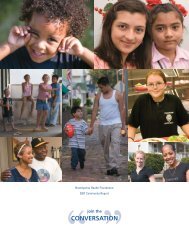2005 Community Report - Brandywine Health Foundation
2005 Community Report - Brandywine Health Foundation
2005 Community Report - Brandywine Health Foundation
You also want an ePaper? Increase the reach of your titles
YUMPU automatically turns print PDFs into web optimized ePapers that Google loves.
ADDRESSING CHILDHOOD WEIGHT MANAGEMENT<br />
The incidence of overweight children<br />
has reached epidemic proportions in<br />
the United States. According to the<br />
American Obesity Association,<br />
30 percent of children ages 6 to 19<br />
are overweight and 15 percent are<br />
obese. In Coatesville, approximately<br />
37 percent of children ages 6-12 and<br />
26 percent of children ages 13-17 are<br />
at risk for obesity, according to the<br />
Philadelphia <strong>Health</strong> Management<br />
Corporation’s 2002 <strong>Community</strong> <strong>Health</strong><br />
Database.<br />
While the overweight problem affects<br />
children at all income levels, one of<br />
the factors at work in Coatesville is<br />
low socioeconomic status: Nearly a<br />
third of Coatesville children under 18<br />
come from families living below the<br />
poverty level, according to the 2000<br />
U.S. Census. Also, while weight<br />
management programs exist in<br />
surrounding communities, transportation<br />
problems and fees charged by such<br />
programs prevent many Coatesville<br />
residents from participating.<br />
To address this critical issue, which<br />
has significant implications for the<br />
healthcare system, the <strong>Foundation</strong><br />
funded a pilot project in spring <strong>2005</strong> at<br />
South <strong>Brandywine</strong> Middle School. The<br />
project was a collaborative effort of<br />
the Southeast Pennsylvania Area<br />
<strong>Health</strong> Education Center of West<br />
Chester, the West Chester University<br />
Department of Public <strong>Health</strong> and the<br />
Coatesville Area School District.<br />
The 16-week pilot, in which 19 girls<br />
participated, included two 90-minute<br />
sessions after school each week. Each<br />
session involved hands-on nutrition<br />
education and a half hour of walking or<br />
hip-hop dance instruction. The goal:<br />
increase the girls’ awareness of the<br />
lifelong benefits of physical activity<br />
and healthy eating and eliminate<br />
sedentary lifestyles.<br />
“I needed to learn more about how to<br />
eat healthy, and I really liked the<br />
hip-hop classes,” says Laura Selin.<br />
“It inspired me to just get out there<br />
and move.” Currently a 7th-grader at<br />
South <strong>Brandywine</strong>, she now snacks on<br />
vegetables instead of potato chips and<br />
sweets, and walks home from school<br />
with a friend.<br />
Laura, in turn, inspired her mother,<br />
Polly Selin. She rethought the food she<br />
was preparing for her family, joined<br />
Weight Watchers, lost 18 pounds and<br />
is now working out regularly at the<br />
local YMCA. “It made me realize Laura’s<br />
really following my lead,” she says.<br />
The <strong>Foundation</strong> not only funded the<br />
program, but also an evaluation of its<br />
effectiveness. Tammy James, Ph.D.,<br />
associate professor of health<br />
education at West Chester University,<br />
conducted the evaluation and<br />
surveyed respondents like the Selins<br />
to determine program effectiveness<br />
and potential improvements.<br />
She concluded that the after-school<br />
nature of the program was convenient<br />
and effective and that the girls felt<br />
more comfortable with the all-female<br />
“It inspired me to just get out there and move.”<br />
Laura Selin, student<br />
South <strong>Brandywine</strong> Middle School<br />
6




